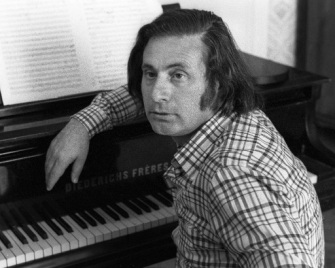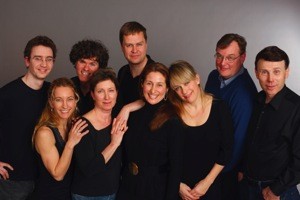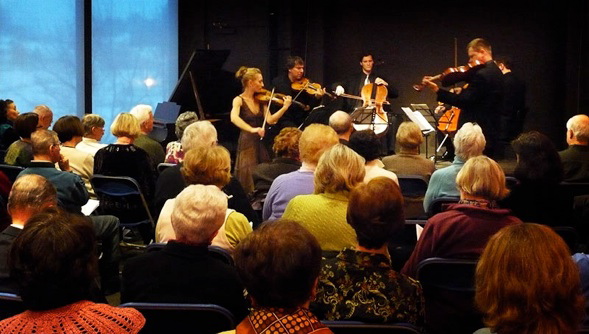Classical Music Review: Worcester Chamber Music Society — A Deeply Memorable Evening of Music Making
The Worcester Chamber Music Society’s combination of repertoire demonstrated how creative programming can lead to highly satisfying musical results: each piece had something to say to or about its neighbors and the cumulative effect of hearing them in such a context made for a deeply memorable evening of music making.
Worcester Chamber Music Society. At United Presbyterian Church, Whitinsville, MA, November 18, 2011.
By Jonathan Blumhofer
Last Friday the British Commonwealth commemorated its annual Remembrance Day, and next Thursday the United States celebrates Thanksgiving. It was appropriate, then, to encounter the program the Worcester Chamber Music Society (WCMS) presented this weekend in concerts in Whitinsville and Worcester. Titled “Remembrances of Things Past,” the program featured a thought-provoking combination of music by Reger, Schnittke, and Brahms. At the performance I attended on Friday in Whitinsville, this combination of repertoire demonstrated how creative programming can lead to highly satisfying musical results: each piece had something to say to or about its neighbors, and the cumulative effect of hearing them in such a context made for a deeply memorable evening of music making.
The concert opened with an engaging account of Max Reger’s Serenade for flute, violin, and viola (op. 141a). Reger was one of the most prolific composers of the early 20th century, having composed hundreds of pieces in virtually every genre save symphonies and operas. Still, he remains one of the least known composers of a generation that included Bartok, Ravel, Schoenberg, and Stravinsky. This is largely due to the fact that Reger’s musical language, which married the late-Romantic, chromatic aesthetic of Wagner and Schoenberg with the classical forms of Beethoven, never gained him a large following in his lifetime; rather, it alienated listeners and critics alike. Since his death in 1916, he has been largely forgotten.
The Serenade, which was written in 1915, shows Reger at his most accessible. The piece falls into three movements, the impish outer ones sometimes sounding like a cross between Johann Strauss and Prokofiev with hints of Brahms, while the slow middle movement is a gorgeous creation, opening with a lovely flute melody and punctuated throughout by falling chromatic lines.
WCMS musicians Tracy Kraus (flute), Krista Buckland Reisner (violin), and Peter Sulski (viola) proved highly agreeable performers. Ms. Kraus dispatched the extended flute solos with sensitivity and agility, especially in the deeply felt middle movement. Though the Serenade is primarily a showcase for the flute, both Ms. Reisner and Mr. Sulski shined in their solo turns and provided thoughtful accompaniment. Throughout the performance, I was impressed by how they effectively brought out contrasts of character and mood and captured the music’s more melancholic turns. The Serenade’s finale, particularly, was filled with great humor, its quiet ending coming as a genuine surprise.
Following the Reger, violinist Rohan Gregory, violist Mark Berger, and cellist David Russell gave a riveting performance of Alfred Schnittke’s extraordinary String Trio. As Mr. Berger wrote in his excellent program notes, the Trio was commissioned by the city of Vienna to commemorate the centennial of Alban Berg’s birth in 1985; Schnittke, who had spent several years living in Vienna during his youth, always associated the city with the music of Schubert and Mozart. Thus the Trio became an homage to the music of an earlier age, as seen through the refracted lens of the late 20th century.

Alfred Schnittke’s extraordinary STRING TRIO pays homage to the music of an earlier age, as seen through the refracted lens of the late 20th century.
One of the trademarks of Schnittke’s mature style was a compositional device known as Polystylism, which featured contrasting and contradictory musical styles in juxtaposition and combination with one another. This technique is on full display throughout the Trio’s two movements to powerful effect: the first movement begins with a simple, diatonic tune that suddenly collides with dissonant clusters. As the movement continues, snatches of melodies, chorales, and dances alternate with furious outbursts and passages of extended techniques. In the second movement, Schnittke essentially freezes time with long stretches of static harmonies interrupted by short melodic ideas and quotations (or near-quotations) of more familiar material.
Mr. Gregory, Mr. Berger, and Mr. Russell were thoroughly convincing in their performance of this daunting score, easily handling the demands Schnittke threw their way. The trio played the bipolar first movement with appropriate fury and gentleness, successfully realizing the music’s sense of sliding into an abyss. Though each member of the ensemble delivered a fully committed performance, Mr. Gregory deserves special praise for his sensitive handling of this movement’s challenging violin part.
In many ways, the second movement is the musical equivalent of a still life. The spirit of Shostakovich is never far removed: at times I felt that Schnittke was evoking the slowly turning, “cinematic” opening of Shostakovich’s Eleventh Symphony in this movement. The ensemble had some memorable moments: of particular note were Mr. Berger’s and Mr. Russell’s account of a short melody played with natural and artificial harmonics (produced by lightly touching the strings with the fingers) and Mr. Gregory’s rendition of a near-quote from Wagner’s Ring Cycle that recurs like an idée-fixe. Throughout the score, it is impressive just how much sound Schnittke asked three instruments to produce: there were times when I was almost convinced I was hearing a string orchestra.
After intermission all the string players who had appeared on the first half of the program were joined by special guest Joshua Gordon of the Lydian Quartet for a full-bodied performance of the Brahms String Sextet (op. 18). In his day, Brahms was considered a staunchly conservative composer, writing music only in traditional forms and carrying on a heated rivalry with the great progressive of the age, Wagner. Though written early in his career, Sextet (1860), contains many of the hallmarks of Brahm’s mature style: rich instrumental textures, complex, rhythmic layering, and a preference for archaic forms and techniques among them.
After the intensity of the Schnittke, the Brahms came as something of a letdown, though, on the whole, it was well played. The ensemble gave the first movement a noble reading, its first theme a showcase for Mr. Russell’s fine cello solo. Despite some minor intonation issues, the movement’s materials were well shaped and, overall, a strong sense of the music’s narrative was conveyed.
The second movement Passacaglia is to my ears the most interesting movement of the entire composition: a set of variations on a recurring harmonic pattern that is filled with unexpected twists and modal shadings. On Friday night, the WCMS gave a finely chiseled account of its granitic opening theme, and the movement’s several variations were played with sensitivity and feeling. One of the evening’s highlights came towards the end of this movement when the music calls for a shift from turbulence to lyricism; the ensemble did so with great delicacy.
A spirited rendition of the third movement Scherzo followed. While I would not have minded hearing a bit more of the music’s humor in its opening measures, the WCMS musicians dug deeper into the character of this movement as they proceeded; the trio and coda were performed with appropriate rustic vigor, with low strings leading the way.
In the finale, Mr. Russell again took full advantage of his opportunity to shine in the opening theme. Throughout this movement, Brahms alternates music of a relaxed demeanor with more aggressive, contrapuntal sections and these contrasts were nicely played up in Friday’s performance. Particularly effective was the section near the middle that foreshadows Brahms’s later Hungarian Dances: the viola playing of Mr. Berger and Mr. Sulski was commendably incisive, while the violins and cellos brought a convincing, Gypsy spirit to the music.


